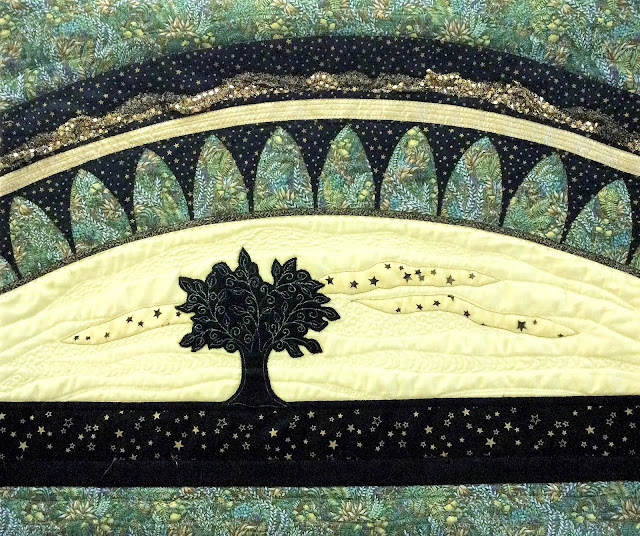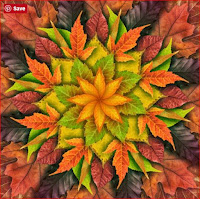Quilt No. 100
November 2018
I
admit it. I’ve been pretty smug about numbering my completed quits, having
started this way back with Quilt Number 1, some twenty years ago. I can’t even
remember how I knew to do that. Possibly it was dictated by some vague
ancestral memory in my DNA. So, when Quilt No. 100 began looming on my horizon
it was significant.
“So,
I guess you’re going to do something really special for your hundredth quilt,
right?” A couple of people said this to
me, echoing a thought that was already sweating it out in a tiny corner of my
brain. The weight of expectation hung on me like a dead pig being carted home
from market. It was true. It needed to be something special. Really
special.
But
what?
The
option of an animal quilt was out. I’d already quilted a fox, bears, a couple
of loons, fish, numerous frogs, penguins, birds (also numerous), elephants,
parrots, dolphins, cats, a dog, and potatoes. Yes, I know that last one is a
vegetable. More serious subjects had
included my series of WWII quilts - a military graveyard, a bomb cloud,
Auschwitz, and Hibakusha (honoring the radiation-affected Japanese people). Less serious and more whimsical was my
song-inspired quilt series - Let It Be,
Welcome to the Jungle, Crystal Blue Persuasion, Road to Shambala, Blue Collar, Private Idaho, Horse with No Name. Then there were the fairy tale themed quilts
- The Princess and the Pea, Who’s There,
The Pond at Old Tranquility Farm. Most quilts tended to be non-series outliers
such as the pre-911 New York City skyline, the Norwalk Christmas (yes, based on
the virus, ugh), the human brain, cactus, and even my own personal Library Cat. No. 100 needed to get past all of these.
I
wasn’t quite sure what I could do to set it apart. One hundred blocks? Too obvious. One hundred colours? Too tricky. One hundred stomach ulcers? Getting closer. Maybe I could drag other people into this
project. Now there was something I
hadn’t done before. An imprecise plan took shape. Involving numerous other
people always makes everything easier, right?
I
thought it over, but not in any great depth. I would ask everyone I knew
to give me a scrap of fabric. And… and… I would take that fabric and make a
leaf for each person and put their name on it. Eventually it would make itself
into a tree, a Tree of Life! How easy
would that be? It was so simple I was almost done before I had even started!
Of
course, as a quilter, I had forgotten that not everyone has piles of fabric
lying around just waiting for someone to request a piece of it. People who do not commune with fabric on a
daily basis would rather give you a twenty dollar bill than try to figure out
how the %$#! they are supposed to come up with a chunk of fabric.
I
put out the call – any fabric, no restriction as to type or colour, and a
3-inch square would be plenty. Now if
that scrap of fabric meant something special, if perhaps it carried a story
with it, so much the better, but that was an optional feature. In March 2013 I sent out my plea via email, Facebook, and at my quilt guild. I held the line at accosting people in my
workplace and strangers in the street.
Envelopes
started arriving in the mail from far and wide.
Fabric scraps were pressed into my hand.
Stories poured forth as friends, mostly non-quilters, gave me their
heartfelt pieces of cloth. Some of those stories are captured in this blog post.
 |
| Arrival of Fabrics |
I
spent most of the summer of 2013 making the leaves. I added stabilizer and backing and cultivated
each fabric fragment into something that would hopefully be worthy of their
individual stories. Each piece had its unique challenge as I worked my way
through bath towels, organza, polyester, PJs, upholstery fabric, neoprene,
paper, socks, ties, and a logo from a baseball cap. I free-motion quilted each
name in gold metallic thread onto each leaf. I got pretty good at doing
script writing with a sewing machine. By
the end of it, I could probably have free-motion quilted a whole blog post, but
I’ll save that fun for another day.
 |
| First Leaves |
After
the leaves were done the whole project pretty much fell off the wagon, into the
ditch, and rolled all the way to the Sargasso Sea of Design Despair. I had a whole lot of leaves, none of which
went with each other. Clumped together
they looked creatively appalling. I was
going to need something to harmonize all these dissimilar pieces. More leaves!
That was the answer! So…I made
many, many (did I mention that it was many?) more leaves from a single piece of
non-print fabric. I chose a lovely green fabric with varying shades, from
quilter/designer Elaine Quehl. This helped harmonize the leaves, but they
were still lacking the main structure – the tree!
 |
| Harmonizing Leaves |
Maddeningly,
I could not come up with a design for the tree.
I looked at trees on the internet, real life trees, trees in books, and dreamed
about trees, most of which were mocking me.
No tree could be found to host my crafted leaves. I put the leaves in a
box where they remained in the dark for a very long time.
Occasionally
someone would give me fabric and I would make a new leaf and add it to the
box. My creative block grew into a wall
that got taller and wider. The project sat untouched as I worked my way through
another fifteen quilts. I just could not come
up with a tree concept. I would pull
everything out, immerse myself in utter despair, and put it all away
again. Guilt and embarrassment about my
creative failure followed me around like a chihuahua Velcro-ed to my leg.
I
am fully aware that not every creative idea comes to fruition, but I had ridden
the horse of failure to a whole new pasture.
If you are going to experience a creative failure, why not involve every
single person you know by asking them to contribute to that project? Why not
amp up your regret by making people sorry they had chopped up favorite
garments, wet suits, sofas, and wedding
dresses, just for you? I had more
than a few anxious nightmares about the folly of this endeavor.
One
day in 2018 my friend Lily phoned me.
She is endlessly supportive and if there was a Nobel Prize for
Encouragement, Lily would be the uncontested winner every year. She was hoping
I’d send her a photo of two quilts I’d made many years ago. These were a pair of memorial quilts that
brought together blocks made by families that had suffered the loss of a
child. I had some difficulty finding the
photo and came across a speech I’d given when the quilts were unveiled to the
families. In the speech I’d outlined how
I’d come up with the design for the quilts.
Each contributed block was completely unique in content, colour, and
design. I’d divided the blocks by colour
and let that guide the final design. The
individual elements had dictated the outcome for something that had a lot
of pieces that did not necessarily go together in an obvious way. This was
pretty much a bingo moment. The tree itself was of little importance. The leaves were the stars of the project.
 |
| Design Wall |
 |
| Strips for Tree Planning |
I
taped up my highly technical and expensive design wall (the white fuzzy back on
a $2 plastic table cloth). I rough cut
some strips from unwanted brown fabric and laid out a prototype for a leaning
tree trunk with a bunch of branches.
 |
| Leaves. Will it Work? |
 |
| Dyed Sky |
I started adding leaves, keeping families grouped together. The leaves did indeed
begin to dictate the design. I could tell that all those
good wishes and beautiful stories would indeed blend into a tree of life for
which I was the sole connecting link.
Eventually, I knew I would end up with this crazy colorful treetop. I had no idea what would be on the quilt
where the treetop ended, other than a leaning tree trunk. More stalling and
creative foot shuffling ensued. How could I ever balance out something so top
heavy? I tried to focus on what such a tree would have beneath it. Well, obviously…a garden!
Uh
oh. Once again, there was no picture of this
garden anywhere in my brain. I bided my
time, dyeing all the background sky fabrics, and assembling them, adding the
finished leaves onto the tree branches.
 |
| Dyed Sky Fabrics |
No fully formed garden grew in my mind.
I
tried to imagine what I would have done to create a garden if the tree wasn’t
there. With no particular plan in mind, I forced myself to just start with some
fabrics and see where that would take me. Several people had given me largish
pieces of fabric for their leaf. Some of
these had flowers or leaves on them. I
added fusible to the back of those ones and started cutting out the individual
flower or leaf shapes from the fabric.
Bit by bit I arranged these into flower beds.
A Tree of Life would most certainly have a
path below it, so I arranged the garden on either side of the path. I came across a frog in my stash. I have made enough frog quilts that others
automatically associate me with frogs.
My tiny central character was born.
After that, it was mere weeks of arranging and top stitching until the
garden had sprung up to grace the pathway and the green hills that I’d dyed for
the background.
The
quilt was now 65 inches tall, a colossal size compared with my other art
quilts. It weighed about as much as
newly birthed elephant, and quilting it on my regular sewing machine (not a
longarm) took the stamina of a Sisyphus and the muscles on a Popeye.
I used rayon and metallic thread as much as possible to pump up the sparkle
quotient.
I
had the tree. I had the garden. I was
almost there! But…I had this great big empty space between them. The green hills looked forlornly empty. Eeesh, yet another bout of creative block
walled me in, and no amount of ice cream bars or cups of coffee could pry me
loose. More time slipped by which
explains how something I began in March 2013 was only finished six years
later in 2019. Finally, I came up with
some long tendrils and tiny leaves sweeping down from the tree. These happily filled in the space and added a bit of motion. They also suggested that in life, there are always new
things to come.
The
Tree was finally finished! It currently hangs at the foot of a staircase
in my house, and when I pass by it each day, I feel the warm presence of
friends and family. And like other
trees, I can never declare it to be completely “finished”. I’m always
hopeful of the possibility that more leaves will be added.

































